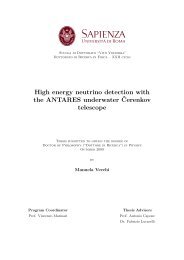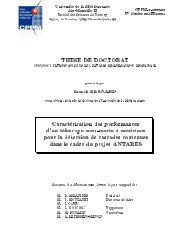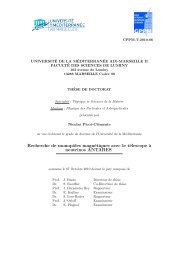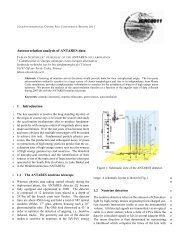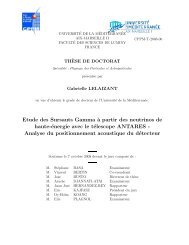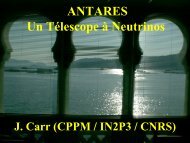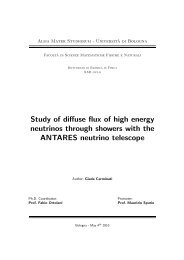- Page 2 and 3: "The most exciting phrase to hear i
- Page 4 and 5: 3.2.1.4 Performance and characteris
- Page 6 and 7: Chapter 1IntroductionThe early hist
- Page 8 and 9: Chapter 2Dark MatterIn this chapter
- Page 12 and 13: Figure 2.4: CMB anisotropy observed
- Page 14 and 15: Figure 2.5: Combination of the WMAP
- Page 17: Figure 2.6: Temporal evolution of t
- Page 20 and 21: Figure 2.9: Parameter space of m 1/
- Page 22 and 23: Figure 2.10: Limits on spin-indepen
- Page 26 and 27: Figure 2.14: Detected gamma ray flu
- Page 28 and 29: 600km/s. If we assume the worst cas
- Page 30 and 31: Figure 2.17: Conversion factor from
- Page 32 and 33: The eigenstate mixing can be writte
- Page 34 and 35: Figure 2.19: Flux of ν µ / ¯ν
- Page 36 and 37: Figure 3.1: The neutral current (NC
- Page 38 and 39: Muon Energy (GeV )1p| dEdx | (GeV.c
- Page 40 and 41: Figure 3.4: Energy loss of per dist
- Page 42 and 43: Figure 3.6: Effective muon range as
- Page 44 and 45: Figure 3.8: Differential flux of at
- Page 46 and 47: 3.2.1.1 Detector layoutOptical Modu
- Page 48 and 49: • The LED (light emitting diode)
- Page 50 and 51: Anchor & BuoyEach line is anchored
- Page 52 and 53: Figure 3.17: Distribution of azimut
- Page 54 and 55: Figure 3.20: Height and radial disp
- Page 56 and 57: Figure 3.22: Distribution of sea cu
- Page 58 and 59: Figure 3.24: Time offset among OMs
- Page 60 and 61:
Figure 3.26: Distribution of time d
- Page 62 and 63:
Line number Connection Date Mainten
- Page 64 and 65:
Figure 3.29: Comparison between sky
- Page 66 and 67:
Figure 3.31: The effective area for
- Page 68 and 69:
Figure 4.1: Median counting rate of
- Page 70 and 71:
Figure 4.4: Average neutrino events
- Page 72 and 73:
2. All hits on the same floor are m
- Page 74 and 75:
4.2.1 Neutrino simulationFigure 4.6
- Page 76 and 77:
• Multiplicity range of the muon
- Page 78 and 79:
Chapter 5Dark Matter search in the
- Page 80 and 81:
Figure 5.2: Annihilation spectrum f
- Page 82 and 83:
Livetime(days) 5 Lines 9 Lines 10 L
- Page 84 and 85:
Figure 5.4: Monte Carlo Truth distr
- Page 86 and 87:
Figure 5.7: Tchi2 distribution for
- Page 88 and 89:
Figure 5.9: Tchi2 distribution for
- Page 90 and 91:
Figure 5.11: Sun’s position taken
- Page 92 and 93:
Figure 5.13: Comparison between the
- Page 94 and 95:
Figure 5.15: Estimation of the back
- Page 96 and 97:
Figure 5.16: Mean angle between the
- Page 98 and 99:
Figure 5.18: A comparison of the di
- Page 100 and 101:
a look at figure 5.22 we find a cle
- Page 102 and 103:
The resulting optimized sensitiviti
- Page 104 and 105:
Figure 5.26: A comparison plot of t
- Page 106 and 107:
dΦ µdE ν= dΦ νdE νP earth ρN
- Page 108 and 109:
Figure 5.31: Limits on the muon flu
- Page 110 and 111:
Chapter 6Dark Matter search in the
- Page 112 and 113:
Figure 6.1: . True Position of the
- Page 114 and 115:
Figure 6.3: Comparison of the three
- Page 116 and 117:
For BBFit all variables mentioned i
- Page 118 and 119:
Figure 6.6: The distribution of χ
- Page 120 and 121:
annihilation channel W + W − the
- Page 122 and 123:
lowering the total contribution of
- Page 124 and 125:
6.4.2 BBFit Single-line analysisThe
- Page 126 and 127:
Figure 6.15: Comparison between the
- Page 128 and 129:
Figure 6.17: Comparison of Nhit dis
- Page 130 and 131:
Figure 6.19: The estimation of the
- Page 132 and 133:
Figure 6.21: Comparison of the opti
- Page 134 and 135:
Figure 6.23: Comparison of sensitiv
- Page 136 and 137:
Figure 6.25: Estimation of our back
- Page 138 and 139:
Figure 6.28: Comparison of the mult
- Page 140 and 141:
Figure 6.29: Comparison of the Λ d
- Page 142 and 143:
Figure 6.31: Comparison of the cos(
- Page 144 and 145:
Figure 6.34: Comparison of the esti
- Page 146 and 147:
The optimal Λ cut for all dark mat
- Page 148 and 149:
Figure 6.40: Sensitivity to neutrin
- Page 150 and 151:
6.7 Comparison with 2007-2008 analy
- Page 152 and 153:
mass of 200 GeV and a cross-section
- Page 154 and 155:
Chapter 7ConclusionsThe limits pres
- Page 156 and 157:
Bibliography[1] Volders, L. M. J. S
- Page 158 and 159:
[22] S. Burles et al., “Big bang
- Page 160 and 161:
[46] G. Debrassi, S. Heinemeyer, W.
- Page 162 and 163:
[74] C. Hettlage, K. Mannheim, and
- Page 164:
[102] D. Heck and J. Knapp, “Fors





